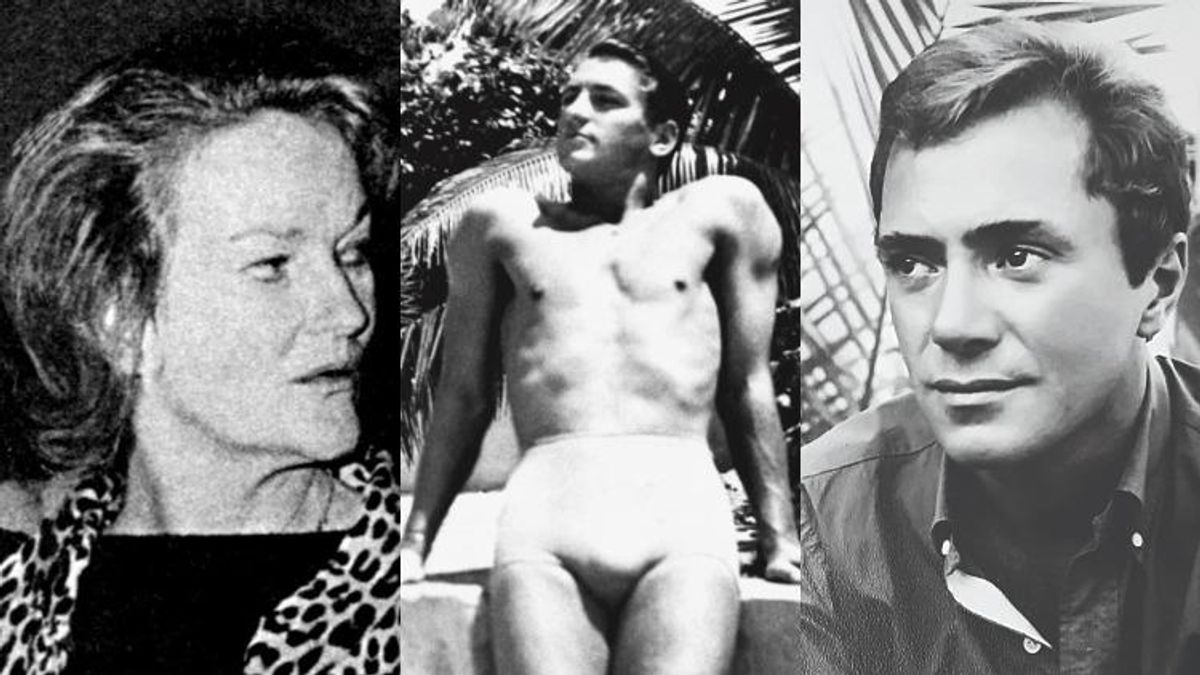It was supposed to be one last goodbye for Eduardo Tirella, a onetime performer and popular milliner who hung with Frank Sinatra before becoming a talented decorator, art curator, and in middle age, a promising movie set designer. Tirella, a gay war hero and Italian-American (back when that was still considered "ethnic" in America) was on the cusp of Hollywood success at 42. A good friend of Sharon Tate, Richard Burton, and other actors, Tirella had just spent a decade curating art projects for the many estates of Doris Duke -- then the richest woman in America.
But, having designed the sets of Elizabeth Taylor's The Sandpiper and Tate's Don't Make Waves, Tirella was moving on from Duke's employ. He'd arranged to join his partner, artist Edmund Kara, who sometimes worked alongside him, in California. Instead, on that fateful 1966 eve in Newport, R.I., Tirella's goodbye became permanent. He ended up crushed under a Dodge Polara station wagon, having been pushed through giant iron gates, dragged 20 feet, and plowed into a tree. To say he was pulverized would not be an exaggeration. No one leaves Doris Duke, it was said. Not even her designer.
In Peter Lance's meticulous book Homicide at Rough Point -- which delves into Tirella's 1966 death, the scant police investigation, subsequent lawsuits, and rumors of a cover-up -- the former ABC News correspondent argues that Tirella knew telling Duke he was leaving could put him in danger. She had, after all, stabbed an ex with a butcher knife during an argument. But Tirella clearly hadn't expected her to slide into the driver's seat, run him down, and keep going until she rammed his body between two tons of steel and the trunk of a tree.

The scene of the crime outside Doris Duke's estate the morning after she killed Eduardo Tirella (courtesy Peter Lance)
Newport authorities may have believed her story -- that it was just a terrible accident -- but Lance's reporting demonstrates that it's just as likely they decided that covering up the unfortunate "incident" was simply in their best interests.
"The town fathers, in general, adopted an almost obsequious solicitation of Doris after she began giving tens of thousands of dollars to the Cliff Walk Restoration Project and Newport Hospital, where she was hidden from state investigators on the evening of the incident," Lance says. (Read our full interview here.) "Further, the Newport Restoration Foundation, which restored 70 colonial-era homes and helped turn Newport into a tourist mecca, was an extension of the murderous quid pro quo that helped Doris Duke escape intent-to-kill murder charges."
Nearly 50 years later, the death of Kirushnakumar Kanagaratnam was met with much of the same official disinterest as Tirella's.
Kanagaratnam arrived in Canada in 2010, aboard the MV Sun Sea, along with 491 other Tamil refugees whose efforts to escape the civil war in Sri Lanka led to a perilous ocean journey in which many others were sickened or died. After being at sea for months, then stuck offshore for weeks, the refugees were finally allowed into Canada to present asylum claims. Like most of them, Kanagaratnam's refugee claim was denied, but he stayed in Canada anyway, living in the margins, making money on odd jobs until two years after he was denied asylum, he was found dead, dismembered, buried in planter boxes in a stranger's tidy suburban yard. Kanagaratnam wasn't the only one either -- seven other men, mostly gay or bisexual men of color, had been killed by the same Toronto man, gay landscaper Bruce McArthur. Like Tirella, Kanagaratnam was also a victim of the media, the police, and a society that ignored his worth in favor of a more convenient narrative.
In his recent book Missing From the Village: The Story of Serial Killer Bruce McArthur, the Search for Justice, and the System That Failed Toronto's Queer Community, author Justin Ling reveals how the intersections of racism, homophobia, transphobia, and police procedures fail queer and trans people. There is a fundamental mismatch between how heavily overpoliced queer and trans people are, Ling says, and yet how fundamentally under-protected and underserved we are, and not just in Toronto, where McArthur operated for decades.

"One thing that I really wanted to hit home with this book was not just that this could happen anywhere, but that it already has -- and, in many places, it's continuing to happen," Ling says. "All you have to do is pick a major North American city and start scrolling through cold cases to find faces of queer people whose killings have remained unsolved for decades. Serial killers targeting gay men were common from the 1970s to the 1990s throughout North America. Today, trans women, and particularly trans women of color, are disproportionately targeted. Even in our grotesquely serial killer-obsessed culture, we spend painfully little time talking about this."
What strikes Ling as so frustrating about the Toronto murders (McArthur is serving life for killing eight men) is that we were supposed to have done better. "We were supposed to have learned all these lessons -- about vulnerable populations, about police-community relations, about ensuring that we never lost track of missing people -- and yet throughout this whole painful story, it seems those lessons were consistently forgotten," he says. (Read our full interview with Ling.) "Men disappeared from the center of the Gay Village, one after another, and we just let it happen."
The gay journalist behind the CBC podcast Uncover, which examined cold cases from the 1970s that were reopened as a result of the McArthur investigation, Ling spent five years of in-depth reporting to tell the full story of police failure, to detail how the queer community responded, and to share the lives of the eight men who went missing and the lives they left behind. In telling that story, Ling uncovers the latent homophobia and racism that kept this case unsolved and unseen. It's a serious look at how police agencies fail to treat missing person cases seriously, and how policies and laws pushed McArthur's victims out of the light and into the shadows.
Police failures tie Ling's book to Lance's, but another thread running through them -- and Allan Levine's Details Are Unprintable: Wayne Lonergan and the Sensational Cafe Society Murder -- is the role the media has played in how it covers (or doesn't) these real-life queer crime stories.
The media never investigated the potential connection between Duke's philanthropy and the decision not to prosecute her for Tirella's death, and instead, it covered the story the way Duke wanted it to. "I don't believe the media was complicit at the time," Lance says now. "But, perhaps worse, they were casual about the death of this man and clearly saw him as some kind of inferior to Doris Duke."

Wayne Lonergan (Getty) and a lurid newspaper headline during his trial (newspapers.com)
Levine, who spent 18 months researching court and police records for Details Are Unprintable, found that media coverage also played a role in the early-1940s murder conviction of Wayne Lonergan, a closeted gay or bi man, for killing his wealthy wife. Although Levine believes Lonergan was the perpetrator, the author maintains that the press coverage of Lonergan's rumored sexuality tilted the jury. "Given the lack of any physical evidence, which today might cause a jury to have doubts, the intense publicity about Lonergan's sexuality no doubt contributed to a preconceived and negative bias about him in the minds of a typical 1940s male heterosexual jury, whose members subscribed to the antigay attitudes of the era," Levine says. (Read our full interview with Levine.)
In the case of Toronto's missing men, Ling says, "The serious media attention came far too late. In 2013, police announced that they believed three missing person cases were likely connected -- underscoring the strong possibility of a serial killer. About six months later, headquarters shut down the investigation. Not one major news outlet followed up to ask why."
Read our interviews with authors Peter Lance, Justin Ling, and Allan Levine now at advocate.com/books.
You can read an excerpt from Homicide at Rough Pointhere. You can purchase a copy at www.amazon.com.





















































































